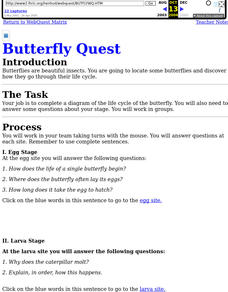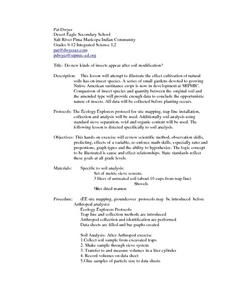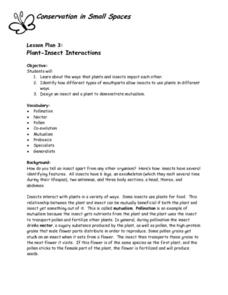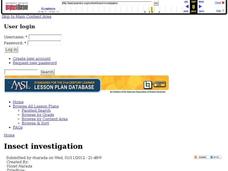Curated OER
Lesson: While You Were Sleeping....
Imagine you are a bug living on a leaf in the painting, Bouquet of Flowers in a Vase by Maria van Oosterwyck. This is what you'll tell your class as they analyze the lovely image. They list details in the painting, find two insects...
Curated OER
Iridescent Insects
Students examine how some insects change colors as they move to camoflauge themselves. Using the internet, they examine their favorite one more closely and make an outline of the body on construction paper. To end the lesson, they add...
Curated OER
Who am I?
Here is a colorful worksheet that has learners identify 16 different kinds of insects. Each insect has an accurate and colorful drawing associated with it. The insect names are at the bottom of the worksheet, and pupils must match up...
Curated OER
Bug Snack
Students create an insect out of food. In this insect characteristics lesson, students review the 3 body parts of an insect and use various foods to create a sample insect. Students learn a song about insect body parts.
Curated OER
Build Your Own Insect Trap
Students ask testable questions. They explain the relationship between insect behavior and insect trapping techniques. Students design their own insect traps to collect a new unknown insect, in the same way that entomologists collect the...
Curated OER
Which One is an Insect?
In this science worksheet, students categorize 18 words as either insects or not insects. Students write the words in a two-column chart under the correct category.
Curated OER
Just Plain Buggy: Art and Science
Budding artists explore the shapes and parts that make insects so fascinating to study, then use what they see to create original insect inspired designs. They use wax, dye, and fabric to create their designs.
Curated OER
Life Cycle
Young scientists explore the world of entomology. They focus on the life cycle of butterflies and moths. They utilize the entire school year in order to see how butterfly eggs turn into the chrysallis, then into a butterfly, who then...
Curated OER
Ants
Ants are a common example to use when conducting lessons on insects, and if your youngsters are squeamish, this is a way to introduce them without actually bringing them into the classroom! Viewers of this PowerPoint learn about the...
Curated OER
Small Creatures in the Home
I suppose there are a lot of different creatures that dwell in our homes. You and your class can learn about the various insects, bugs, and spiders that call our houses home. The house fly, furniture beetle, silver fish,...
Curated OER
Butterflies
Butterflies and moths are the stars of this biology resource. In it, learners see how to distinguish a butterfly from a moth. They discover new vocabulary, perform an experiment, and do some coloring on pages that are embedded in the...
Curated OER
Bug's Eye View
Investigate the life of bugs and how they interact with the environment in this integrated science and language arts instructional activity. Young scientists construct mini environments in cages in order to make observations. This data...
Curated OER
Butterfly Quest
This worksheet calls for young scientists to create a diagram of a butterfly's life cycle and then answer a series of short-answer and fill-in -the-blank questions. The questions are broken down by the stages of a butterfly's life cycle:...
Curated OER
Spider Watching
Spiders are creepy, crawly - and interesting! Young entomologists learn about parts of a spider's body, their habitats, ways spiders catch their prey, and what they most like to eat. Some excellent art activities are included in the plan...
Curated OER
Feelin' Buggy
Students discuss five senses, compare and contrast human and insect senses, use adjectives to describe things they touch, smell, and see, and write stories in first person describing what it would be like to be size of insect.
Curated OER
Endangered Species in the Sonoran Desert
Learners identify and explain some caused of endangerment and extinction for species as well as explain the effects of extinction on an ecosystem. Teachers use this lesson plan before teaching students about collecting insects or plants.
Curated OER
Do new kinds of insects appear after soil modification?
Students explore and experiment with the concept do new kinds of insects appear after soil modification. They assess and review scientific methods of observation, predicting, variables, math skills, ratio, proportions, graphs and the art...
Curated OER
Butterflies
In this science and reading comprehension worksheet, students read a 1 page detailed passage about butterflies. Students then answer 7 questions.
Curated OER
Conservation in Small Spaces: Plant-Insect Interactions
Learners explore ways that plants and insects impact each other, identify how different types of mouthparts allow insects to use plants in different ways, and design an insect and a plant to demonstrate mutualism.
Curated OER
Insect Investigation
Investigation is a brilliant way to spark scientific inquiry. First graders will identify, research, and report what they have learned about a mysterious bug found on the playground. They will use multimedia resources for research and...
Curated OER
Fabulous Fireflies
Bring the magic of fireflies to your classroom! Using a toilet paper tube, wiggly eyes, and yellow (or glow-in-the-dark) paint, you can make your own firefly.
Curated OER
Megabeasts
Create larger-than-life insects for the classroom. Bugs are usually pretty small, but during the Jurassic period they were huge. Kids use diagramming and scale conversion to enlarge a modern day insect so that it is as big as its ancient...
Curated OER
Piece by Piece
Put an insect together piece by piece with a fun and artistic puzzle project. To increase small group collaboration, learners use photos of insects cut into one-inch squares to create an enlarged puzzle version of the image. Extension...
DePaul University
The Working Tools of Insects
The animal kingdom is full of interesting organisms that have unique ways of surviving. Children read about different insects that have special tools for building homes and protecting themselves. When finished, learners identify the main...























